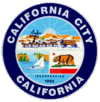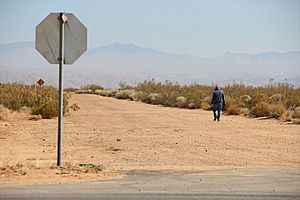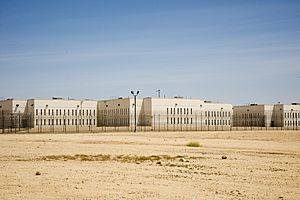California City, California facts for kids
Quick facts for kids
California City, California
|
||
|---|---|---|
| City of California City | ||
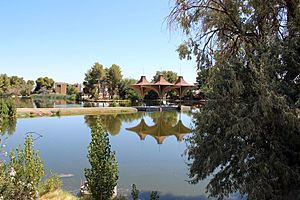
West Side of California City Central Park
|
||
|
||
| Nickname(s):
Cal City
|
||
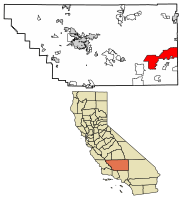
Location of California City in Kern County, California.
|
||
| Country | United States | |
| State | California | |
| County | Kern | |
| Incorporated | December 10, 1965 | |
| Named for | California | |
| Area | ||
| • Total | 203.70 sq mi (527.57 km2) | |
| • Land | 203.61 sq mi (527.35 km2) | |
| • Water | 0.09 sq mi (0.22 km2) 0.04% | |
| Elevation | 2,405 ft (733 m) | |
| Population
(2020)
|
||
| • Total | 14,973 | |
| • Density | 73.54/sq mi (28.39/km2) | |
| Time zone | UTC−08:00 (PST) | |
| • Summer (DST) | UTC−07:00 (PDT) | |
| ZIP Codes |
93504-93505
|
|
| Area codes | 442/760 and 661 | |
| FIPS code | 06-09780 | |
| GNIS feature IDs | 1660418, 2409960 | |
California City is a city located in northern Antelope Valley in Kern County, California, United States. It is 100 miles (160 km) north of the city of Los Angeles, and the population was 14,120 at the 2010 census. Covering 203.63 square miles (527.4 km2), California City has the third-largest land area of any city in the state of California, and the largest city by land area in California that is not a county seat and/or the state capital.
Much of the workforce of Edwards Air Force Base, which is located 18 miles (29 km) southeast of the city, is made up of city residents. Other major sources of employment include California City Correctional Center (California Department of Corrections and Rehabilitation); Mojave Air and Space Port and its flight test operations; and the Hyundai/Kia Proving Grounds located in the rural southwestern part of the city. California City has a park, a PGA golf course, and a municipal airport.
Contents
History
Early
The area where California City now exists was largely uninhabited prior to the 1960s. Padre Francisco Garcés, a Franciscan missionary, camped at Castle Butte in what is now California City in 1776 during the Juan Bautista de Anza expedition of modern-day California and Arizona, then part of Alta California.
In the late 19th century, the Twenty Mule Team Trail, which carried loads of borax to the railhead in Mojave from Harmony Borax Works mines in the east, ran through the California City area.
Town
California City had its origins in 1958 when real estate developer and sociology professor Nat Mendelsohn purchased 80,000 acres (320 km2) of Mojave Desert land with the aim of master-planning California's next great city. He designed his model city, which he hoped would one day rival Los Angeles in size, around a Central Park with a 26-acre (11 ha) artificial lake. Growth fell well short of his expectations. Today, a vast grid of crumbling paved roads which define residential blocks, extend well beyond the developed area of the city. Satellite photos underscore its claim to being California's 3rd largest geographic city, 34th largest in the US. California City was incorporated on December 10, 1965. This could be considered an example of a failed planned city.
Although areas of California City have not developed as expected, California City has grown from 3,200 people in 1985 to over 14,000 in 2009. Cerro Coso Community College closed escrow on 22 acres (89,000 m2) in the heart of California City for a Community College to serve Edwards AFB, California City, Mojave, Boron, North Edwards and the entire high desert in the Antelope Valley.
The first post office opened in 1960.
Geography
According to the United States Census Bureau, the city has a total area of 203.6 square miles (527 km2), of which 0.1 square miles (0.26 km2) or 0.05% is water. Although one of California's smaller cities in terms of population, California City is the third largest city in California by land area (34th in the United States, and 21st when consolidated city-counties are excluded).
Climate
| Climate data for California City, CA | |||||||||||||
|---|---|---|---|---|---|---|---|---|---|---|---|---|---|
| Month | Jan | Feb | Mar | Apr | May | Jun | Jul | Aug | Sep | Oct | Nov | Dec | Year |
| Average high °F (°C) | 58 (14) |
62 (17) |
66 (19) |
72 (22) |
81 (27) |
91 (33) |
97 (36) |
96 (36) |
90 (32) |
79 (26) |
66 (19) |
58 (14) |
76 (25) |
| Average low °F (°C) | 34 (1) |
37 (3) |
41 (5) |
46 (8) |
54 (12) |
62 (17) |
67 (19) |
66 (19) |
59 (15) |
49 (9) |
39 (4) |
33 (1) |
49 (9) |
| Average precipitation inches (mm) | 1.34 (34) |
1.51 (38) |
1.13 (29) |
0.22 (5.6) |
0.15 (3.8) |
0.05 (1.3) |
0.16 (4.1) |
0.27 (6.9) |
0.28 (7.1) |
0.28 (7.1) |
0.43 (11) |
0.81 (21) |
6.63 (168.9) |
| Source: The Weather Channel | |||||||||||||
Demographics
| Historical population | |||
|---|---|---|---|
| Census | Pop. | %± | |
| 1970 | 1,309 | — | |
| 1980 | 2,743 | 109.5% | |
| 1990 | 5,955 | 117.1% | |
| 2000 | 8,385 | 40.8% | |
| 2010 | 14,120 | 68.4% | |
| 2020 | 14,973 | 6.0% | |
| U.S. Decennial Census | |||
2000
According to the census of 2000, there were 8,385 people in 3,067 households, including 2,257 families, in the city. As of 2006[update], the city's population grew 8.9% from 12,106 to 13,219. California City outpaced rivals Palmdale and Lancaster, making the city the 12th fastest growing city in California. This also made California City the fastest growing city in the Antelope Valley. The population density was 41.2 inhabitants per square mile (15.9/km2). There were 3,560 housing units at an average density of 17.5/sq mi (6.8/km2). The racial makeup of the city was 68.19% White, 12.82% Black or African American, 1.56% Native American, 3.73% Asian, 0.32% Pacific Islander, 7.43% from other races, and 5.94% from two or more races. 16.96% of the population were Hispanic or Latino of any race.
Of the 3,067 households, 39.0% had children under the age of 18 living with them, 55.8% were married couples living together, 13.0% had a female householder with no husband present, and 26.4% were non-families. 21.2% of households were one person and 7.2% were one person aged 65 or older. The average household size was 2.72 and the average family size was 3.15.
The age distribution was 30.7% under the age of 18, 7.3% from 18 to 24, 27.7% from 25 to 44, 23.5% from 45 to 64, and 10.7% 65 or older. The median age was 36 years. For every 100 females, there were 99.5 males. For every 100 females age 18 and over, there were 99.0 males.
The median income for a household in the city was $45,735, and the median family income was $51,402. Males had a median income of $44,657 versus $28,152 for females. The per capita income for the city was $19,902. About 12.5% of families and 17.3% of the population were below the poverty line, including 28.0% of those under age 18 and 12.4% of those age 65 or over.
31% of the male population were public administrators in 2006. Public administration is the most common job in California City.
Although the growth of the city has not met its founders' expectations, California City has seen substantial population growth over the past several years. The Demographic Research Unit of the California Department of Finance estimated California City's population at 12,048 as of January 1, 2006. California City's population increased an estimated 4.2% in 2005, over three times the growth rate of the state as a whole. California City currently ranks 345th out of 478 incorporated cities in California, up from 348th in 2005.
In the 2004 Presidential election, 66% voted for the Republican candidate, and 32% voted for the Democratic candidate. In 2016 the vote for president was 53% Republican and 40% Democratic.
2010
At the 2010 census California City had a population of 14,120. The population density was 69.3 people per square mile (26.8/km2). The racial makeup of California City was 9,188 (65.1%) White (39.9% were non-Hispanic whites), 2,150 (15.2%) African American, 132 (0.9%) Native American, 367 (2.6%) Asian, 59 (0.4%) Pacific Islander, 1,431 (10.1%) from other races, and 793 (5.6%) from two or more races. Hispanic or Latino of any race were 5,385 persons (38.1%).
The census reported that 11,506 people (81.5% of the population) lived in households, no one lived in non-institutionalized group quarters and 2,614 (18.5%) were institutionalized.
There were 4,102 households, 1,611 (39.3%) had children under the age of 18 living in them, 1,980 (48.3%) were opposite-sex married couples living together, 630 (15.4%) had a female householder with no husband present, 287 (7.0%) had a male householder with no wife present. There were 335 (8.2%) unmarried opposite-sex partnerships, and 22 (0.5%) same-sex married couples or partnerships. 949 households (23.1%) were one person and 312 (7.6%) had someone living alone who was 65 or older. The average household size was 2.80. There were 2,897 families (70.6% of households); the average family size was 3.30.
The age distribution was 3,449 people (24.4%) under the age of 18, 1,294 people (9.2%) aged 18 to 24, 4,617 people (32.7%) aged 25 to 44, 3,570 people (25.3%) aged 45 to 64, and 1,190 people (8.4%) who were 65 or older. The median age was 34.8 years. For every 100 females, there were 144.0 males. For every 100 females age 18 and over, there were 160.1 males.
There were 5,210 housing units at an average density of 25.6 per square mile, of the occupied units 2,474 (60.3%) were owner-occupied and 1,628 (39.7%) were rented. The homeowner vacancy rate was 8.3%; the rental vacancy rate was 22.5%. 6,584 people (46.6% of the population) lived in owner-occupied housing units and 4,922 people (34.9%) lived in rental housing units.
Sports
The California City Whiptails were a professional baseball team competing in the unaffiliated Pecos League. The team folded in 2019. Their home games were played at Balsitis Park.
Infrastructure
Schools
Mojave Unified School District serves California City:
- California City Jr/Sr High
- California City Middle
- Hacienda Elementary school
- Robert P. Ulrich Elementary School (1966)
Private prison
Studies for a privately built and owned 2000-4000-bed prison on the east side of town began in 1995, and an environmental impact statement on a 550-bed facility was completed in 1996. Contracts were signed between the city and Corrections Corporation of America and it was built in 1999. The 2304-bed California City Correctional Facility prison housed federal inmates for the U.S. Marshal Service and U.S. Immigration and Customs Enforcement from 2006 to 2013, then was leased to the California Department of Corrections and Rehabilitation in 2013 for $28.5 million yearly in response to a federal order to reduce overcrowding at the state's prison facilities.
Transportation
California City is served by Highway 14 to the west and Highway 58 to the south. Kern Transit provides direct bus service to Mojave, Lancaster, and Ridgecrest with connections to Tehachapi and Bakersfield. The direct line to Lancaster also provides a direct connection with Metrolink's Antelope Valley Line, with service into Los Angeles. Within the city, California City Dial-A-Ride (DAR) Transit provides transportation on a demand-response basis on weekdays (except on holidays when City Hall is closed).
Business
The 3,967 acres (1,605 ha) Hyundai-Kia proving grounds are in the city boundaries. 640 acres (260 ha) are in use.
Public safety
As an incorporated city that does not contract with Kern County, California City has its own police and fire departments.
Images for kids
See also
 In Spanish: California City para niños
In Spanish: California City para niños


